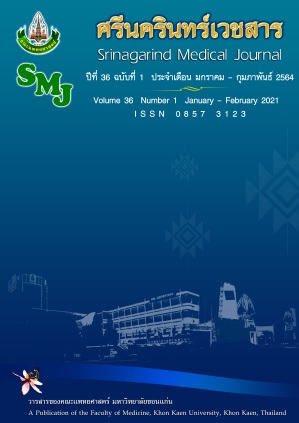Radiation Doses at Eye Lens and Thyroid Gland of Patients and Medical Staffs Received from Video Fluoroscopy
Keywords:
radiation dose in eye lens and thyroid; fluoroscopy; OSLAbstract
Background and Objective: This study aimed to measure radiation exposure to eye lens and thyroid of patients and medical staffs during x-ray fluoroscopy. The measurement of area radiation dose inside and outside of fluoroscopic room were also observed. The radiation dose to eye lens and thyroids from different fluoroscopic techniques were measured in head phantom.
Methods: Optically stimulated luminescence (OSL) dosimeters were placed on eyes and thyroid of patients and staffs, and head phantom for radiation dose measurement. The survey of area radiation dose was conducted using OSL dosimeters.
Results: Patients underwent fluoroscopy received the highest dose at right thyroid at 645.4 µSv/min. Staff’s thyroid and hands received radiation dose in the range of 1-2.4 µSv/min. The radiation doses inside and outside fluoroscopic room were in the safety level. The different fluoroscopic techniques affect the resolution and noise of images. The continuous fluoroscopic technique releases higher radiation dose than the pulse fluoroscopic technique.
Conclusions: Radiation protection considerations can be performed by adjusting the appropriate exposure techniques, using the radiation protective equipment, training and providing staff knowledge’s. Also, the monitoring of personal dose received from work will enhance an individual self’s awareness of radiation protection.
References
2. Sanchez RM, Vano E, Fernandez JM, Rosati S, Lopez-Ibor L. Radiation doses in patient eye lenses during interventional neuroradiology procedures. Am J Neuroradiol 2016; 37(3): 402–407.
3. Vañó E, Cosset JM, Rehani MM. Radiological protection in medicine: Work of ICRP Committee 3. Ann ICRP 2012; 41(3–4): 24–31.
4. Barnard SGR, Ainsbury EA, Quinlan RA, Bouffler SD. Radiation protection of the eye lens in medical workers-basis and impact of the ICRP recommendations. Br J Radiol 2016; 89(1060): 20151034
5. Donadille L, Carinou E, Brodecki M, Domienik J, Jankowski J, Koukorava C, et al. Staff eye lens and extremity exposure in interventional cardiology: Results of the ORAMED project. Radiat Meas 2011; 46(11): 1203–1209.
6. Chau KHT, Kung CMA. Patient dose during videofluoroscopy swallowing studies in a Hong Kong public hospital. Dysphagia 2009; 24(4): 387–390.
7. Kim HM, Choi KH, Kim TW. Patients’ radiation dose during videofluoroscopic swallowing studies according to underlying characteristics. Dysphagia 2013; 28(2): 153–158.
8. Beck TJ, Gayler BW. Image quality and radiation levels in videofluoroscopy for swallowing studies: A review. Dysphagia 1990; 5(3): 118–128.
9. Geijer H. Radiation dose and image quality in diagnostic radiology. Optimization of the dose-image quality relationship with clinical experience from scoliosis radiography, coronary intervention and a flat-panel digital detector. Acta Radiol Suppl 2002; 43(427): 1–43.
10. Engel-Hills P. Radiation protection in medical imaging. Radiography. 2006;12(2):153–160.
11. Le Heron J, Padovani R, Smith I, Czarwinski R. Radiation protection of medical staff. Eur J Radiol 2010; 76(1): 20–23.
12. Amis Jr. ES, Butler PF. ACR white paper on radiation dose in medicine: Three years later. J Am Coll Radiol 2010; 7(11): 865–870.




